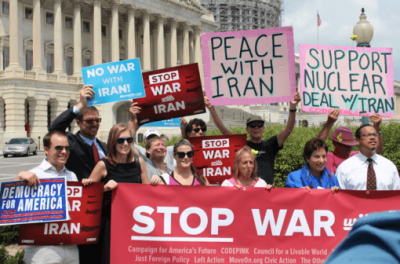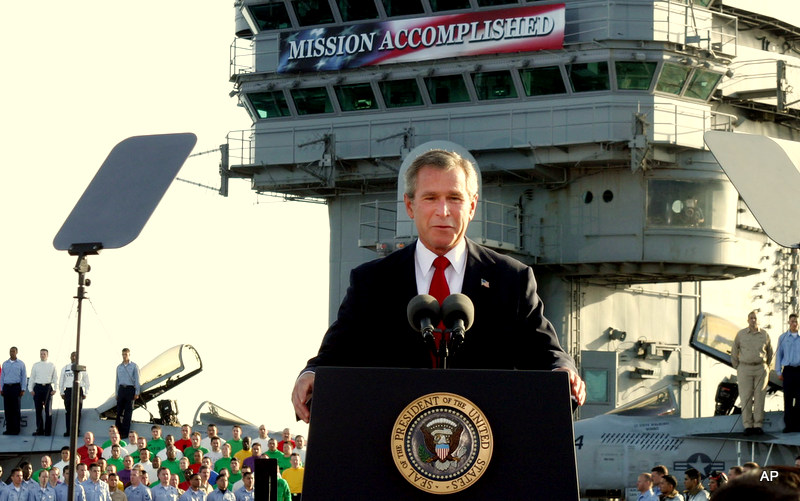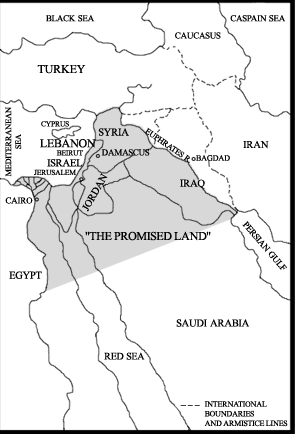US Destabilization Plan for Iran and the Middle East, and the Need to Strengthen the Resistance

The use of force, in total disregard for the UN Charter, international law, and international agreements, is today, more than ever before, the main characteristic of Washington’s policy decisions. Consequently, the world is experiencing a decisive shift to militarization rather than, and in negation of, regional and international diplomacy, in US approach to policy. Now, the particular locus of this violation of the world peace and security is the Middle East and the anti-imperialist Iran, in particular.
In the previous section (1), I examined the US agenda of global domination (2) under the direct influence of the Neo-Conservative “Project for the New American Century” (3). In this section, the question will be further investigated in the framework of another Neocon project, the “Greater Middle East Initiative” (4). The initiative which is claimed to promote ‘democracy and human rights’(5) in the region, was part of President Bush’s “forward strategy of freedom,” by which the US-led expansion of political rights and political participation in the Muslim world is imputed to combat the appeal of Islamist extremism.
Examining the claim, I seek to shed some light for a better understanding of the real intentions behind such US regional initiatives. Finally, I attempt to advance the future prospects of the regional resistance to the continuing US-Israeli attempts at destabilization in the Middle East.
The Greater Middle East Initiative
The 2003 US invasion of Iraq triggered a massive and growing tide of objections and disgust around the world, particularly in the Middle East. The US was seen as dishonest, unlawful and unduly heavy-handed, in the conduct of its “War on Terror”, especially as Iraq had clearly no part in the 9/11 terrorist event, and the claims of Iraq’s clandestine WMD were unmasked as sheer lies, post-invasion. Under these revealing circumstances, the only justification (illegal, of course) that the Bush administration could come up with for its illegal invasion of Iraq, was the down fall of a criminal dictator, and the US’ ex-ally, Saddam Hussein, and the claim to have granted the Iraqi people the prospects of democratic governance. On this basis, the US chose to move on with another Neocon plan, more specific to the region, and under the fake cover of ‘democracy and human rights’.
The Greater Middle East Initiative formulated in 2004 and re-labeled by Condoleezza Rice in 2006 as the New Middle East, aimed for the US global domination under the banner of “democracy promotion”. It covered a wide area of land, stretching to Morocco, in the north of Africa, all the way to the western borders of China, and the newly independent countries in Central Asia and Caucasus to the north, bordering the Russian Federation. It was not accidental that all the countries covered by the Greater Middle East plan were largely populated by Muslims, with varying degrees of potential opposition to US domination.
The title of “Greater Middle East” was chosen as a less provocative, more appealing name for a project whose aim was to strengthen and expand the US domination over the predominantly Muslim nations in the Middle East and beyond. This agenda is clearly evident in the US grand strategy, as defined by Admiral Cebrowski in 2001, and published in 2004 by his assistant Thomas Barnett, “all of the Greater Middle East must be destroyed except for Israel, Jordan and Lebanon.“(6)
The previous US Army officer and historian, Andrew Bacevich, in his book, “America’s War for the Greater Middle East” (2016), states that
“… this region is the theatre for a series of conflicts dating back to 1980, which heralded the start of the Iran-Iraq war.”
While the statement is true at face value, its absence of context is a glaring omission, rendering the meaning obscure, at best. There’s no trace in that statement of the US’ leading role in instigating the Iraq’s war against Iran and its wide ranging and unconditional support to Saddam Hussein, even as he was using chemical weapons and other inhuman means and methods of warfare against Iran. Equally glaring is the absence of any reference to the US’ responsibility for the “series of conflicts” in the region to the present time.
“Since then”, Professor Bacevich continues, “the US has been involved in balancing conflicts amongst these culturally interconnected nations in order to further its interests in the region.”
It is clear that the purpose of the US’ involvement far from ‘resolving’ any conflicts amongst the nations or the promotion of democracy, has been “balancing” or exploiting the existing fault lines and conflicts and even fabricating new ones to further its own hegemonic interests in the region.
Unfortunately, this had been the abysmal level of responsibility of a permanent member of the UN Security Council, the highest body responsible for ensuring international peace and security, claiming legitimacy and competence for leading the world to ‘peace and prosperity’.

In George W Bush’s vision, the Greater Middle East Initiative was “a strategy aimed at exporting the American democratic model to the Arab-Islamic world and redefining borders and nations in tune with America’s geopolitical ambitions.” (7) The initiative was devised mainly to bring the emerging tide of terrorism (8), which was increasingly getting out of US control, especially in countries such as Saudi Arabia, Iraq, Syria and Afghanistan, back under its control. As usual, this happened at the expense of the security and prosperity of the Middle Eastern nations. Firstly, since the “American democratic model” was to be militarily enforced, it inevitably led to massive violence and destruction; and secondly, if the initiative ever ‘succeeded’, it would emerge over the ruins of the nations’ most valuable assets -their national sovereignty, identity, independence, and national and regional cohesion and unity.
As a consequence of this ‘democracy’ initiative, Lebanon was invaded by Israel in 2006, mainly with the objective of crushing the Islamic resistance, led by the Lebanese Hezbollah, against Zionist incursions and destabilizing efforts. With the embarrassing defeat of the Israeli military again, after its defeats in 1985 and 2000 by Hezbollah pushing the Israeli army out of Lebanon, Libya and then Syria became the targets of US/Israeli ‘democracy’ agenda.
Soon after NATO’s attack on Libya, the wealthiest nation in Africa, and the brutal overthrow of Qadafi in 2011, Syria’s democratic government was subjected to US/Israeli agenda of regime change, destabilization and geographical disintegration. Supported by their NATO and Middle Eastern allies, recruiting, funding, arming and training armies of extremist jihadist and mercenaries from across the globe, Syria was turned into a blood bath, under the banner of ‘democratic revolution’. The fate of the Iraqi nation, caught in a vicious engineered sectarian war from which ISIS emerged, was no better than their Syrian neighbors.
In 2004, US aborted the Paris Agreement, related to Iran’s peaceful nuclear activities, reached in negotiations with France, Germany and the United Kingdom. The US act disrupted the prospects of constructive political and economic co-operations between Iran and the European Troika, which was taking root in a progressive manner. The US action, rather, lead to nearly a decade of increasing sanctions against Iran, US-supported terrorist attacks against Iranian scientists, and the specter of another out-break of war looming over Iran and the Middle East region. Now, with another US President completely under the spell of the Neocons, again a nuclear agreement, the JCPOA, hard won through painstaking negotiations between Iran and the P5+1, in which the Obama Administration played a leading role, is subject to seriously destructive US threats, in a world bent on another world war.
In 2015, with Afghanistan, Iraq, Libya and Syria burning, Yemen became the target of inhumane blockade and bombardment by Saudi Arabia’s coalition with the arming and active participation of the US and the UK in the war room, bombing Yemenis towns and infrastructure whilst blockading urgently needed humanitarian supplies of medication, food and other life-saving essentials, affecting 20 million people.
The US’s‘democratic’ Initiative is intended to transform the borders and nations of the Middle East, in line with the Greater Middle East project, to subordinate entities with narrow cultural identity and diminished self-esteem – that is, populations who would be alienated from themselves and from each other – at the service of the US Empire, itself subservient to Zionist expansionist dreams. It would not be difficult then, in the words of Gilbert Acchar,
The Greater Israel Plan
Israeli Oded Yinon plan for the formation of “Greater Israel” (1982) has important similarities to the Neocon’s plan for the Middle East. As described by Israel Shahak and Prof Michael Chssudovsky in “Greater Israel: The Zionist Plan for the Middle East, (January 2018) (10), it
“constitutes the cornerstone of powerful Zionist factions within the current Netanyahu government, the Likud party, as well as within the Israeli military and intelligence establishment.”
 The two plans are basically overlapping. The Greater Israel project, however, is a more blunt version of the Neocon Greater Middle East plan. For instance, it openly calls for the fragmentation of the regional states, including Iraq, Syria, Lebanon, Egypt and Saudi-Arabia; moving Israel’s capital to Jerusalem (Qods); forcing Palestinians out of what is left of their homeland in the West Bank and Gaza; etc.
The two plans are basically overlapping. The Greater Israel project, however, is a more blunt version of the Neocon Greater Middle East plan. For instance, it openly calls for the fragmentation of the regional states, including Iraq, Syria, Lebanon, Egypt and Saudi-Arabia; moving Israel’s capital to Jerusalem (Qods); forcing Palestinians out of what is left of their homeland in the West Bank and Gaza; etc.
Fading of the US Empire
The current US position, especially with regard to the Middle East, is more ludicrous than ever before. In the heat of the 2016 presidential campaign, Trump, accused his Democratic rival, Hillary Clinton, as the “co-founder” of ISIS, arguably the most notorious terrorist group in recent history, and Obama, the sitting president, as “the founder” (11). Now, however, with Trump himself in office, with his startlingly shameless hallmark of self-contradiction, he continues, to provide support to IS. The US is currently re-arming and re-organizing IS, following the terrorist group’s heavy military losses and the subsequent downfall of its self-proclaimed government in Iraq and Syria.
The IS terrorists’ loss of captured territory and their crushing defeat in November 2017, at the hands of the powerful regional Axis of Resistance, comprising Syria, Iraq, Lebanon and Iran, with Russian support, was indeed a Zio-Neocon defeat. However, with the continued strong support IS and other terrorist groups receive from the US and its allies, the people in the Middle East and beyond are faced with the horrors of violent waves of terrorist attacks, for the foreseeable future, for which the US is directly responsible. Of course, Iran and other members of the Axis of Resistance would not allow the re-grouping and re-emergence of IS, as a viable force. But, despite the eradication of ISIS which was the US’s stated excuse for being in Syria, the Trump administration has announced its intention to stay in Syria indefinitely (12) to stop the “re-emergence” of ISIS and to counter the “strategic threat from Iran” (13). Therefore, as with previous US administrations, Trump administration continues to waste billions of the US tax-payers’ money, and countless lives including those of US Service men and ordinary citizens, in pursuit of its dream of global domination.
US’s brutal and lawless adventurism based on delusions of exceptionalism, greed, gross injustice, deceitfulness, coercion and violence – militarily or otherwise – and its illegitimate grip on resources in the Middle East, would not last. The people in the region are, more than ever before, awakened and angry with the destabilizing role of the US and her allies in the Middle East. This awareness is increasingly shared by the global population, including many European and US citizens, who consider the US global lawlessness as a mortal threat to international peace and security and view their prospects and that of future generations, with a sense of foreboding and dread.
The Need to Strengthen the Resistance
It is very unlikely that the Neocon-led US Administration would change course, with or without Trump. Hence, the reemergence of Daesh or Daesh-like US-sponsored violent terrorist groups (14), in the region, are very likely. It is, therefore, vital for the regional and global peace and security, that the Axis of Resistance, with its proven capabilities, is preserved, supported, strengthened and expanded.
The Axis of Resistance is essential, not only to stamp down on regional terrorism, but also in view of the presently dominant militaristic approach and the unprecedented unpredictability of the US government, increasing the likelihood of lengthy future military confrontations with Zio-Neocon forces, and/or their proxies. To compel Washington and its allies to understand the futility and the unacceptably high costs of their military approach to the Middle East, unity and cooperation within and among the current regional Axis of Resistance and its powerful allies – Russia and China – have to be further expanded and deepened. The Axis of Resistance need to regionally and globally expand and strengthen.
The time has long passed when the US or its Zionist client/master could invade and occupy peaceful states in the Middle East, with impunity. Since early 1980s, when the US and Israeli occupying forces were pushed out of Lebanon, – the first time the Israeli forces were pushed out of an Arab land – the precious invincibility myth of the Israeli military cracked and fell into pieces by the courage and determination of the newly founded Lebanese Hezbollah forces. Inspired by the Islamic Revolution in Iran, and in view of the repeated defeats in recent decades borne by the US and Israel in their military aggressions in the Middle East, from the resistance in Gaza, to Syria, to Iraq, to Yemen, to Lebanon, the invincibility myth is now unraveled and buried under the feet of the regional Resistance.
Nevertheless, for the regional resistance to be enduring and most effective in its arduous and unequal struggle against the Zio-Neocon forces, it has to be truly united, in all its layers, encompassing not only the states and armies, but within and between the populations of Iran, Iraq, Lebanon, Syria, Pakistan, Afghanistan, etc. The enemy is extremely violent. Thus, the struggle is both hard and unequal.
The Importance of National and Regional Unity
Therefore, unity, both within the Resistance and the populations it emanates from is essential. However, this requires insightful leaderships, able to understand the pressing economic and social needs and problems of the populations. An enduring resistance is born out of the determination to defend and preserve that which is worth defending and preserving. It is rooted in the sense of belonging, trust, justice and hope for the future. An insightful leadership should be able to devise socially just and effective solutions to lighten – make bearable – the sufferings of the population whose unity, sacrifice, and resistance it seeks, and to aim to ameliorate their sufferings and legitimate social and economic grievances as its domestic priority.
This requires wide-ranging consultations to hear all voices and people’s prevailing grievances, protests and opposing views. Social justice and the rule of law, progressively implemented at all social levels, starting with and with particular focus on those at the lower ranks of society, and the reduction in economic and social inequality, should become a norm and a priority, as should be leadership and representatives accountability to the public. Equally important is the role of free and responsible media to bring transparency and dialogue to public debate. All these measures and their strengthening help generate and maintain people’s confidence in their governments and their enduring and strong standing in support of the resistance to Zio-imperialist military threats and destabilization plots.
This would create a greater prospect for expanding the resistance regionally and globally and would attract the world’s public opinion, particularly in the West – where the Zio-imperialist war propaganda is powerful and ubiquitous – in support of the resistance. This would help synergize global unity in resistance to Zio-Neocon’s wars and destabilization attempts, starting in the Middle East, and expanding to pave the way to the possibility of regional and global peace, security, social justice and prosperity for all.
*
Dr. Farhad Shahabi is a senior specialist in international relations and disarmament in Iran.
Notes
1) America Persistently Seeks to Destabilize Iran and Undermine Tehran’s Regional Influence in the Middle East, Global Research, January 10, 2018 https://www.globalresearch.ca/america-persistently-seeks-to-destabilize-iran-and-undermine-tehrans-regional-influence-in-the-middle-east/5625541/
2) ‘Neocon 101: What do Neoconservatives Believe? Some basic questions answered’ Global Research, November 12, 2015, Christian Science Monitor 7 August 2007: “Neocons” believe that the United States should not be ashamed to use its unrivaled power – forcefully if necessary – to promote its values around the world.”
https://www.globalresearch.ca/neocon-101-what-do-neoconservatives-believe/6483/
3) REBUILDING AMERICA’S DEFENSES – Strategy, Forces and Resources For a New Century, A Report ofThe Project for the New American Century September 2000 http://www.informationclearinghouse.info/pdf/RebuildingAmericasDefenses.pdf
4) ‘The New U.S. Proposal for a Greater Middle East Initiative: An Evaluation’, Tamara CofmanWittes, Brookings Institute, May 10, 2004,
http://www.mintpressnews.com/ever-happened-bushs-greater-middle-east-initiative/198496/
6) After the ISIS Caliphate, Rojava’ Thierry Meyssan, Global Research, September19, 2017
https://www.globalresearch.ca/after-the-isis-caliphate-rojava/5610383/
http://www.mintpressnews.com/ever-happened-bushs-greater-middle-east-initiative/198496/
8) ‘Terrorists or “Freedom Fighters”? Recruited by the CIA’ Professor John Ryan,Global Research, Dec 20, 2015
https://www.globalresearch.ca/terrorists-or-freedom-fighters-recruited-by-the…/5429766/
9) ‘Greater Middle East: the US plan’, Gilbert Achcar, Le Monde diplomatique, Apr. 2004, https://mondediplo.com/2004/04/04world
10) “Greater Israel”: The Zionist Plan for the Middle East,The Infamous “Oded Yinon Plan”, Introduction by Michel Chossudovsky, Dec. 8th, 2017,
https://www.globalresearch.ca/greater-israel-the-zionist-plan-for-the-middle-east/5324815
11) Donald Trump calls Barak Obama ‘founder of ISIS’ and Hilary Clinton its co-founder, The Independent, August 11, 2016
https://www.npr.org/2018/01/18/578800229/tillerson-says-u-s-to-stay-in-syria-indefinitely
13) US troops will stay in Syria to counter strategic threat from Iran, Washington Post, January 17, 2018
https://www.washingtonpost.com/world/middle_east/us-troops-will-stay-in-syria-to-counter-strategic-threat-from-iran/2018/01/17/eeed9d16-fb8f-11e7-9b5d-bbf0da31214d_story.html?utm_term=.995412d8279e
14) “Going After” the Islamic State. Guess Who is Behind the Caliphate Project? Prof Michel Chossudovsky, Global Research, 12 September 2014
https://www.globalresearch.ca/going-after-the-islamic-state/5401439

